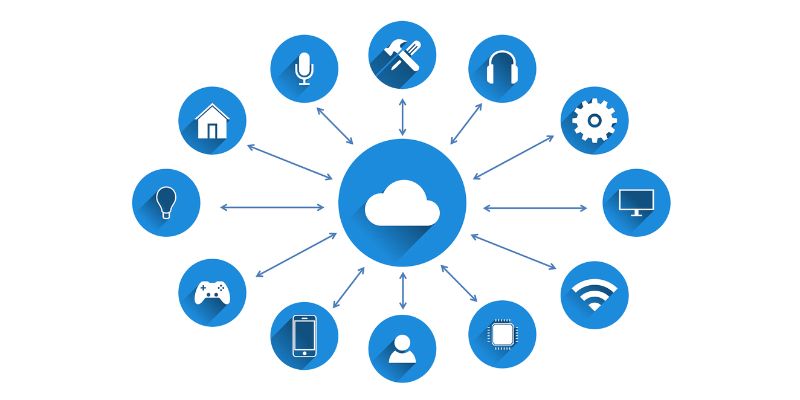How blockchain improves security in IoT devices is a game-changer, folks. Imagine a world where your smart gadgets talk to each other without the risk of being snooped on or hacked. That’s the secure future we’re all craving, right? Well, blockchain is here to make that dream a solid reality. By weaving this tech into the fabric of IoT, we’re talking about a fortress of safety for all your connected devices. In this deep-dive, I’m going to walk you through the nitty-gritty of how blockchain turns your smart home or office into a virtually impenetrable castle. Buckle up, because it doesn’t get more exciting—or secure—than this!
Enhancing IoT Security through Blockchain Integration
The Role of Distributed Ledger Technology in IoT
Blockchain is like a digital ledger that no one can mess with. Each piece of data is like a digital block. These blocks link together to form a chain. Imagine it as a book where the pages are the blocks. Once written, no one can change the words without everyone knowing. This keeps IoT gadgets safe.
This tech makes sure a device’s history stays untouched. It tracks each device’s move on a shared network. Every change is clear to all. This stops bad actors from messing around with our devices. Trust builds as everyone can see the device’s history.
Blockchain does more than just track. It secures our sensitive IoT bits. This happens using tricky math called cryptography. It’s like writing a note in a secret code that only you and a friend can read. It scrambles the data so only the right people see it. This way, bad guys can’t snatch our data.
Because of blockchain, our smart gadgets can talk safely. They send info back and forth without fear. The network uses strict rules for these talks. All devices must follow them. This is like having a strong guard who checks ID before letting anyone in.
Security in IoT is a big puzzle. But blockchain can be the piece we need. It locks down data and makes sure it stays safe. And it keeps everyone honest by allowing us to trace every step. Good security with blockchain means no surprises. And in the IoT world, that’s what we all want.

Ensuring Immutable Data Records and Secure Transactions
Data is like a gold mine in the Internet of Things (IoT). Every bit is precious. So keeping it safe is a big deal. Blockchain helps by making data records set in stone. When data goes on the blockchain, it’s like writing it in wet cement. Once it dries, you can’t change it without smashing the whole sidewalk.
Why is this cool for IoT devices? It means once we save something, it’s safe forever. Think about turning on a smart light with your phone. This action gets saved in the blockchain book. It can’t be unseen or twisted by anyone.
And when we talk about buying and selling with IoT, blockchain steps up. It makes sure our deals go smoothly. You can think of it as a promise. When we shake hands on a deal, blockchain is the glue that holds that handshake tight. It helps devices talk business without us worrying.
IoT needs to keep out hackers and nasty bugs. Blockchain is like a superhero shield. It guards against the bad stuff and makes sure things stay in tip-top shape. When it comes down to it, blockchain keeps our IoT world turning without a hitch. It’s the buddy we all want by our side in this digital age.
Strengthening IoT Encryption and Device Authentication
Tailoring Cryptographic Algorithms for IoT Devices
IoT devices need strong protection. That’s where blockchain steps in. Let’s look at how. First up, cryptographic algorithms. These are complex codes to lock data tight. But IoT gadgets are small. They often lack the power to run standard algorithms. So, we tailor them. We create special versions that suit IoT’s unique needs. These lean, mean codes give top-notch security without draining the device.
What does this do for IoT device authentication? A whole lot, really. It means each device can prove it’s legit. It’s like a secret handshake only true IoT devices know. This keeps out the fakes and the frauds.

Advanced Blockchain Identity Verification Mechanisms
Now, let’s dive into blockchain identity verification. Ever heard of “smart keys”? They’re digital ID cards but way smarter. Blockchain makes these smart keys. They’re nearly impossible to fake. Each IoT device gets one. It helps them talk safely to other devices and networks. It’s all very high-tech but so vital for keeping our digital world safe.
When a device wants to connect, it shows its smart key. The network checks this with blockchain. If it matches, great! The device joins the party. If not, the door stays shut. This way, we guard against sneaky intruders.
These blockchain-backed methods don’t just protect. They also keep IoT data private. They make sure only the right eyes see the right stuff. And they handle IoT secure transactions. These are like deliveries that need a secure path from A to B.
We turn to decentralized IoT ecosystems for extra safety. With no central command post, hackers have a harder time striking. It’s like trying to rob a building with a hundred doors. Where do you start?
Blockchain IoT encryption gives data a shield. Data bolts from device to device in secret code. Hackers get their hands on it? Well, it’s all gibberish without the key.
In conclusion, from blockchain for device integrity to end-to-end IoT encryption, we’re outfitting the IoT world like a digital fortress. We’re making it tough for the bad guys to even get a foot in. The aim is a network of smart devices that are not just smart, but secure. Secure enough to stand up to the wildest cyber storms.

Crafting a Secure IoT Ecosystem with Smart Contracts and Access Control
Deploying Smart Contracts for Automated IoT Operations
Smart contracts are game changers for IoT security. They let devices deal with user data safely. Think of them as unbreakable promises in the digital world. They enforce rules for how IoT devices work together, without needing a person to watch over them.
Imagine your smart home. A smart contract could let your door unlocks as your car pulls up. That’s because the door knows the car has permission. This is not future talk; it’s happening now. These contracts make sure only trusted devices and people can connect.
With smart contracts, we build trust into the IoT world. They cut out middlemen, reducing chances for data to get stolen. Every time a device acts, the contract checks the rules first. This keeps our digital things in line and secure.
Implementing Blockchain for Robust Device Integrity and Access Management
Blockchain boosts how IoT devices prove they are trustworthy. Each device gets a unique ID, like a digital fingerprint. A ledger, or record book, keeps track of these IDs. Only devices with the right ID can join the network or make changes.
Think of it like VIP access. In IoT, devices need special permission to connect or do tasks. Blockchain manages this. It checks a device’s ID before letting it in. This stops thieves from faking a device’s ID to steal data or cause harm.
Blockchain also means that once something is recorded, it stays put—no take-backs. This immutability stops bad players from changing data to hide their tracks. It also makes it easy to check device histories. This helps tell if someone tampered with a device.
Lastly, blockchain’s way of storing data across many places keeps the whole network safe. Even if one part gets attacked, the rest still protect your data. This distributed security is key for a world with billions of connected devices.
In sum, using smart contracts and blockchain, we craft a secure world for IoT. This keeps our digital helpers honest and our data safe. We can look ahead to a time where breaches are tales of the past. And we do this by building strong, smart systems now.
By integrating smart contracts and blockchain identity checks, IoT becomes safer than ever. With secure networks and data we can trust, the future shines bright for our connected lives.
Overcoming IoT Cybersecurity Challenges with Scalable Blockchain Solutions
Preventing IoT Hacking and Tampering through Decentralized Architectures
Imagine your house with devices talking to each other, making life easier. That’s IoT! But one thing bugs us – hacks and tampering. Good news: blockchain is here to help. How so? It’s all about spreading out the control instead of one spot holding all the power. Kind of like having a team of heroes instead of just one – way harder to beat!
Think of blockchain as a digital ledger, but supercharged. When we use blockchain for IoT security, we make it tough for bad guys to mess with our devices. Each device becomes a team player, checking on others to keep things safe. Makes sense, right? Nobody can trick the system when everyone’s watching.
Blockchain lets devices talk securely and proves they’re legit. No more fakes! It’s like a secret handshake only the real good guys know. This way, IoT devices can trust each other and you can trust them too.
Plus, we get something called immutability. It’s a fancy word for “can’t change”. Once data goes into the blockchain, nobody can tweak it, not even a bit. Hackers hate that! They can’t cover their tracks or change records. That keeps your devices safe and data clean. And you get to relax, knowing your cool smart home is also a safe one.
Ensuring Scalable and Interoperable Blockchain Networks for IoT
Now, what about when we have lots and lots of IoT devices? A traffic jam in data can slow things down. But blockchain’s smart; it’s built to handle crowds. It grows as more devices join, keeping things smooth. Like a superhighway expanding lanes when more cars show up.
We also want IoT gadgets to understand each other, no matter who made them. Blockchain helps here too. It creates rules all devices follow, letting them ‘talk’ no matter their brand. It’s like teaching them a universal language so they all get along.
To keep everything in sync, there are these neat things called consensus mechanisms. They make sure all blockchain entries are agreed upon by everyone – kind of like a team decision. It’s fair, and no single device can call all the shots. This way, we trust the system because it works together as a whole.
If you’re just getting used to all this, it might sound tricky. But I promise, it’s like learning to ride a bike. At first, it’s “Whoa, how does this work?” Then, it’s a breeze. And before you know it, your IoT world is safer and smarter, thanks to blockchain. No more worrying about bad players when your IoT team is solid as a rock!
In this post, we’ve explored how blockchain can make IoT safer for us all. We’ve seen the power of distributed ledgers to keep data safe and how tough encryption and smart identity checks stop bad actors in their tracks. Smart contracts and access rules also help keep our IoT devices in line and secure.
Finally, we talked about how blockchain can grow and adapt, which is vital for the future of IoT. The tech is strong and can change as needed, stopping hackers and keeping our IoT world safe. So we’re not just looking at quick fixes. We’re building a better, safer future with blockchain and IoT together. Thanks for reading! Let’s keep pushing for security that grows with our tech.
Q&A :
How does blockchain enhance security for IoT devices?
Blockchain provides a decentralized and tamper-proof ledger that enhances security for IoT devices by ensuring data integrity and preventing unauthorized access. Each transaction or data block is encrypted and linked to the previous block, creating a secure chain. This makes it difficult for hackers to manipulate the data without being detected.
What are the benefits of integrating blockchain with IoT security?
Integrating blockchain with IoT security offers several benefits, including improved data privacy, enhanced trust between devices, and reduced risk of single points of failure. This decentralized approach allows for secure peer-to-peer communication, transparent data records, and efficient device authentication and verification protocols.
Can blockchain prevent DDoS attacks on IoT networks?
Blockchain can help mitigate the risk of Distributed Denial of Service (DDoS) attacks on IoT networks by distributing the data across a network of nodes, making it harder for attackers to target a single server or resource. Additionally, the use of consensus algorithms in blockchain can prevent malicious nodes from disrupting the network.
How does blockchain ensure the authenticity of IoT devices?
Blockchain ensures the authenticity of IoT devices through the use of cryptographic signatures and immutable records. Each device in the network can be assigned a unique digital identity, which is verified through the blockchain. This prevents counterfeit devices from joining the network and ensures secure device-to-device communication.
In what ways does blockchain technology address data privacy concerns in IoT?
Blockchain technology addresses data privacy concerns in IoT by allowing for secure and anonymous data transactions. The use of encryption and smart contracts ensures that sensitive data is only accessible to authorized parties. Moreover, blockchain’s immutable nature provides a verifiable and transparent audit trail for all data exchanges, reducing the risk of data breaches and unauthorized access.



